683. Tawny-flanked Prinia Prinia subflava (Bruinsylangstertjie)
Order: Passeriformes. Family: Cisticolidae
Description
Size 11-12 cm. A small, brown backed bird with long brown tail, rufous edges to the wings and buff underparts, but paler on the chest with a white throat. The tail feathers have a white tip and a dark subterminal band. Pale supercillium and the lores are dark. Red eye. The bill is black; legs and feet are pinkish-brown. The sexes are alike.
Non-breeding birds have horn-coloured bills and a longer tail than breeding birds.
Juveniles have pale yellow underparts and a yellowish bill.
Similar species: Buffy underparts and flanks and rufous wing panel distinguish it from non-breeding and juvenile Black-chested Prinias, which have yellowish belly.
Distribution
Common from southern Asia to much of sub-Saharan Africa, from Senegal to Ethiopia south to southern Africa (eastern South Africa North to Mozambique, Zimbabwe and Northern Botswana and westwards into Northern Namibia).
Habitat
Dense, tangled vegetation and the understorey of broad-leaved woodland, particularly along watercourses; also in gardens.
Diet
Tawny-flanked Prinias usually forage on bare ground, although they may hawk insects from the air. They feed mainly on invertebrates such as beetles, flies, caterpillars and termites. They may also feed on nectar, particular that of aloes.
Breeding
Tawny-flanked Prinias are monogamous. The nest is built by both sexes, consisting of a pear or oval-shaped structure with a side entrance, built of woven green grass which hardens and turns to pale brown as it dries. It is typically attached with grass to a few upright stems of a sapling, tall shrub, sedge, tall tuft of grass or bush, often over shallow water or moist ground. Egg-laying season is almost year-round, peaking from November-March. It lays 2-5 eggs (varying in colour from pale buff to pink to greenish-blue), which are incubated by both sexes for about 13-14 days. The chicks are fed by both parents, leaving the nest after about 10-20 days.
Parasitised by Cuckoo Finch.
Call
The call is short, wheezy and rapidly repeated. The song is a monotonous series of shrill notes przzzt-przzzt-przzzt and loud piping teep-teep-teep. The male often sings from an exposed perch. Listen to Bird Call.
Status
Common resident. Altitudinal movements recorded in winter months. Usually in pairs or small family parties.
Africa Wild Bird Book
Tawny-flanked Prinia
Dewi
What is the good of having a nice house without a decent planet to put it on? (H D Thoreau)
What is the good of having a nice house without a decent planet to put it on? (H D Thoreau)
Tawny-flanked Prinia Photos
683. Tawny-flanked Prinia Prinia subflava
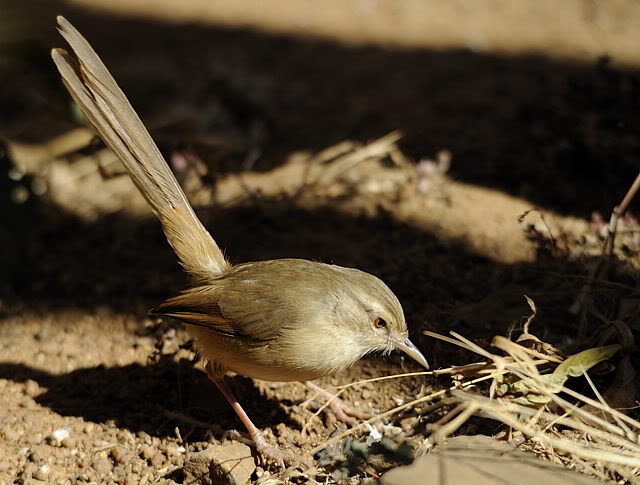 © Dewi
© Dewi
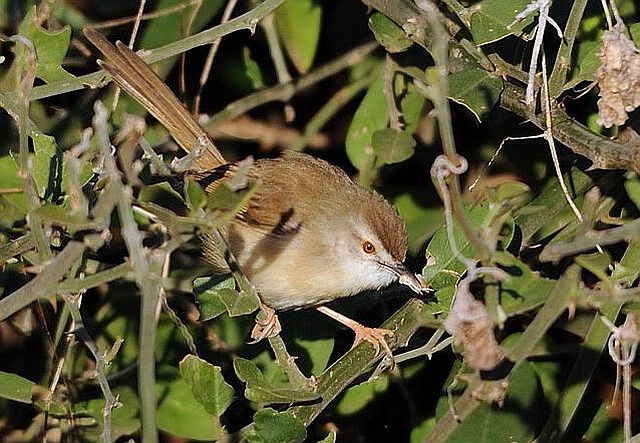 © Dewi
© Dewi
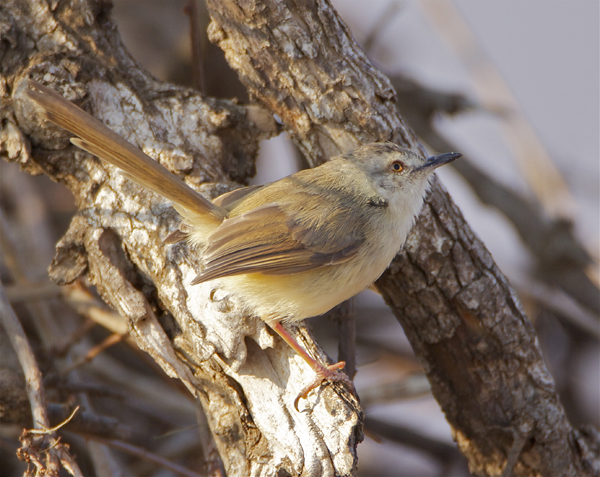 © ExFmem
© ExFmem
Kruger National Park
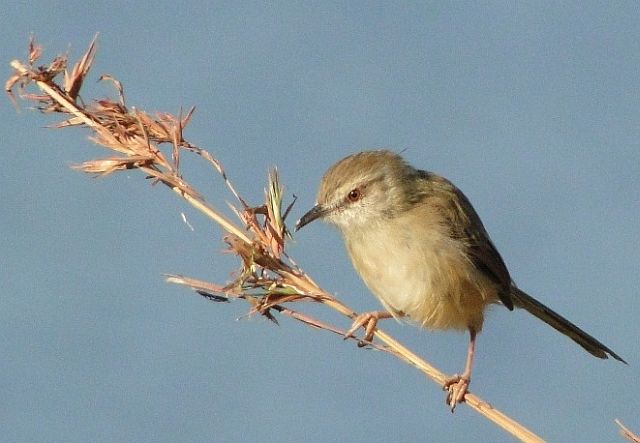 © JustN@ture
© JustN@ture
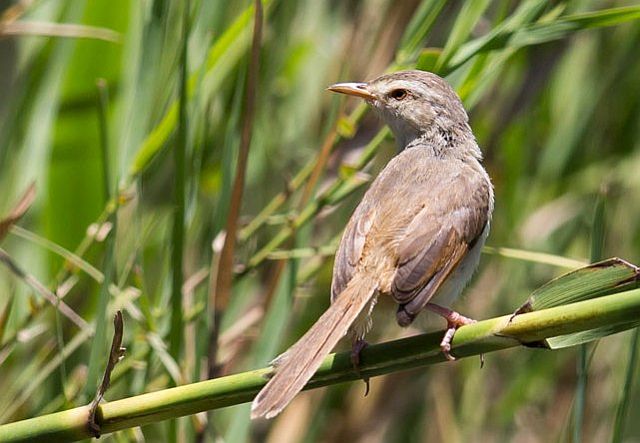 © Pumbaa
© Pumbaa
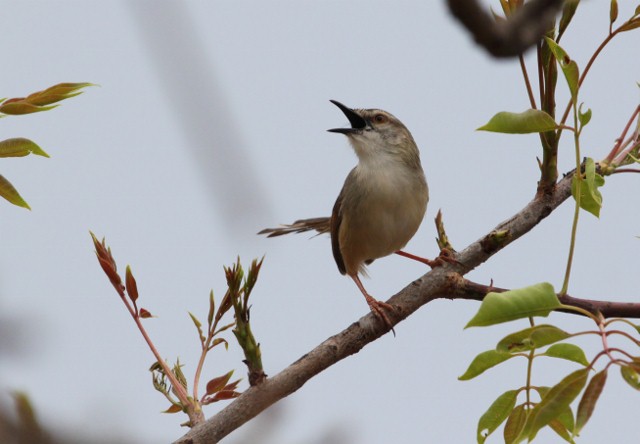 © nan
© nan
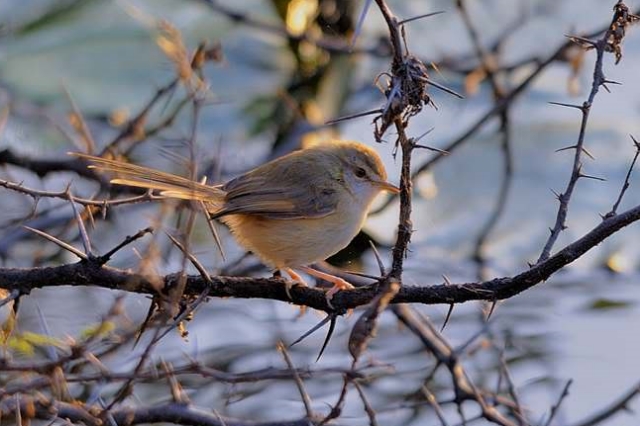 © Dewi
© Dewi
Lake Panic, Kruger National Park
Links:
Species text Sabap1
Sabap2
 © Dewi
© Dewi © Dewi
© Dewi © ExFmem
© ExFmemKruger National Park
 © JustN@ture
© JustN@ture © Pumbaa
© Pumbaa  © nan
© nan © Dewi
© DewiLake Panic, Kruger National Park
Links:
Species text Sabap1
Sabap2
Dewi
What is the good of having a nice house without a decent planet to put it on? (H D Thoreau)
What is the good of having a nice house without a decent planet to put it on? (H D Thoreau)
Black-chested Prinia
685. Black-chested Prinia Prinia flavicans (Swartbandlangstertjie)
Order: Passeriformes. Family: Cisticolidae
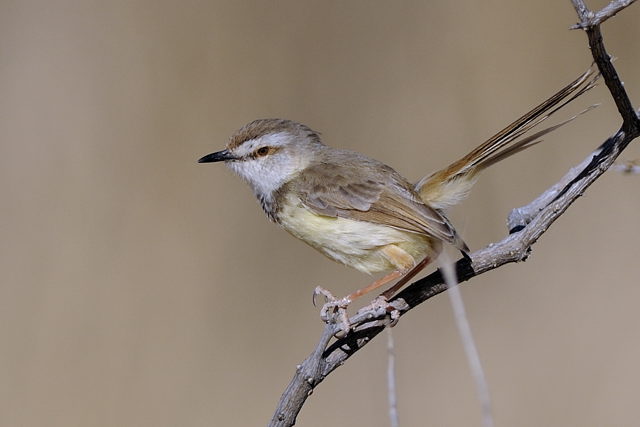
Description
Size: 14 cm. Weight: 9 g. Warm brown upperparts; white chin and throat; and pale cream or yellow underparts. White supercilium. The tail is long and graduated; eyes are brown; legs and feet pinkish and the bill is black. Female has narrower breast band than male.
Ad breeding: Forehead to nape pale earth-brown. Cheeks and ear coverts greyish white; supercilium and face white, lores speckled black. Remainder of upper parts, incl tail, pale earth-brown. Tail strongly graduated, with central rectrices 24-30 mm longer than outermost; each rectrix with narrow dusky brown subterminal spot. Upper wing coverts and flight feathers pale earth-brown, underwing coverts and axillaries whitish. Chin and throat white; lower breast with broad blackish-brown band. Belly, flanks and undertail coverts pale lemon yellow. Bill black. Eyes brown to yellowish brown. Legs and feet pale brown to pinkish.
Ad non-breeding: As breeding adult, but paler and more tawny on mantle, back, rump and upper tail coverts. Breast band indistinct or absent.
Juvenile: As non-breeding adult, but underparts yellower; tail shorter.
Similar species: In non-breeding plumage the bird lacks chest band and might be mistaken for Tawny-flanked Prinia, but it lacks the russet edges to the wing feathers and is usually washed yellow below.
In transitional plumage, the black band on the chest may be replaced by streaking, and it may then be easily confused with the adult or juvenile Karoo Prinia. Drakensberg Prinia has yellow (not white) throat.
Distribution
Central & Northern South Africa, Namibia, Botswana and Western Zimbabwe. The Black-chested Prinia is near-endemic to southern Africa, extending beyond the atlas region only into southern Angola and western Zambia. Its centre of abundance is in the Kalahari. It is also abundant in the southwestern Transvaal, Free State and the northern Cape Province. It extends marginally into the eastern Transvaal and eastern Cape Province. It is widespread in Namibia, confined and local in the drier southwestern part of Zimbabwe, and occurs marginally in the lowlands of Lesotho.
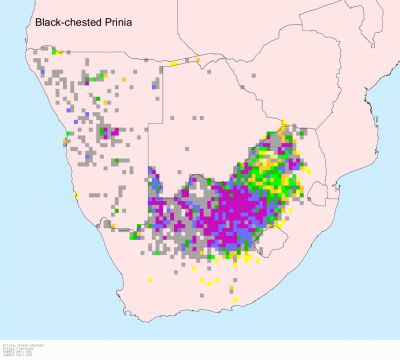
Habitat
Common in shrubland (in both arid and semi-arid climates), dry Acacia savanna with scattered bushes, edges of drainage woodland in dry areas, fallowed cropland with large bushes and gardens in rural villages.
Diet
Black-chested prinias feed while hopping about in low bushes, catching moths, aphids caterpillars and the like. They also feed on nectar from aloes and other plants.
Breeding
Monogomous. The nest is built by both sexes in roughly 11-12 days, consisting of a thin-walled oval or pear-shape with a side-top entrance, built of woven green grass which eventually become dry and pale brown. It is typically placed about 1 metre above ground in the stems of a bush, shrub, thorny tree or sapling, or occasionally a clump of tall grass. Egg-laying season is year-round, peaking from September-April. It may breed opportunistically after rainfall in Winter, while it is still in non-breeding plumage. The female lays 2-6 green eggs, which are incubated for about 12-15 days. The chicks are fed by both parents, they fledge at 11 to 15 days.
Parasitised by Cuckoo Finch.
Call
Their call is a loud buzzy chip-chip-chip or a loud, repetitive zzzrt-zzzzrt-zzzrt-zzzrt note. Listen to Bird Call.
Status
Common resident.
Order: Passeriformes. Family: Cisticolidae

Description
Size: 14 cm. Weight: 9 g. Warm brown upperparts; white chin and throat; and pale cream or yellow underparts. White supercilium. The tail is long and graduated; eyes are brown; legs and feet pinkish and the bill is black. Female has narrower breast band than male.
Ad breeding: Forehead to nape pale earth-brown. Cheeks and ear coverts greyish white; supercilium and face white, lores speckled black. Remainder of upper parts, incl tail, pale earth-brown. Tail strongly graduated, with central rectrices 24-30 mm longer than outermost; each rectrix with narrow dusky brown subterminal spot. Upper wing coverts and flight feathers pale earth-brown, underwing coverts and axillaries whitish. Chin and throat white; lower breast with broad blackish-brown band. Belly, flanks and undertail coverts pale lemon yellow. Bill black. Eyes brown to yellowish brown. Legs and feet pale brown to pinkish.
Ad non-breeding: As breeding adult, but paler and more tawny on mantle, back, rump and upper tail coverts. Breast band indistinct or absent.
Juvenile: As non-breeding adult, but underparts yellower; tail shorter.
Similar species: In non-breeding plumage the bird lacks chest band and might be mistaken for Tawny-flanked Prinia, but it lacks the russet edges to the wing feathers and is usually washed yellow below.
In transitional plumage, the black band on the chest may be replaced by streaking, and it may then be easily confused with the adult or juvenile Karoo Prinia. Drakensberg Prinia has yellow (not white) throat.
Distribution
Central & Northern South Africa, Namibia, Botswana and Western Zimbabwe. The Black-chested Prinia is near-endemic to southern Africa, extending beyond the atlas region only into southern Angola and western Zambia. Its centre of abundance is in the Kalahari. It is also abundant in the southwestern Transvaal, Free State and the northern Cape Province. It extends marginally into the eastern Transvaal and eastern Cape Province. It is widespread in Namibia, confined and local in the drier southwestern part of Zimbabwe, and occurs marginally in the lowlands of Lesotho.

Habitat
Common in shrubland (in both arid and semi-arid climates), dry Acacia savanna with scattered bushes, edges of drainage woodland in dry areas, fallowed cropland with large bushes and gardens in rural villages.
Diet
Black-chested prinias feed while hopping about in low bushes, catching moths, aphids caterpillars and the like. They also feed on nectar from aloes and other plants.
Breeding
Monogomous. The nest is built by both sexes in roughly 11-12 days, consisting of a thin-walled oval or pear-shape with a side-top entrance, built of woven green grass which eventually become dry and pale brown. It is typically placed about 1 metre above ground in the stems of a bush, shrub, thorny tree or sapling, or occasionally a clump of tall grass. Egg-laying season is year-round, peaking from September-April. It may breed opportunistically after rainfall in Winter, while it is still in non-breeding plumage. The female lays 2-6 green eggs, which are incubated for about 12-15 days. The chicks are fed by both parents, they fledge at 11 to 15 days.
Parasitised by Cuckoo Finch.
Call
Their call is a loud buzzy chip-chip-chip or a loud, repetitive zzzrt-zzzzrt-zzzrt-zzzrt note. Listen to Bird Call.
Status
Common resident.
Dewi
What is the good of having a nice house without a decent planet to put it on? (H D Thoreau)
What is the good of having a nice house without a decent planet to put it on? (H D Thoreau)
Black-chested Prinia Photos
685. Black-chested Prinia Prinia flavicans (Swartbandlangstertjie)
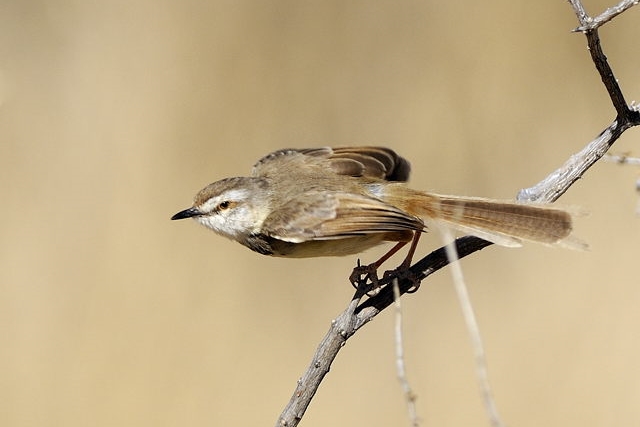
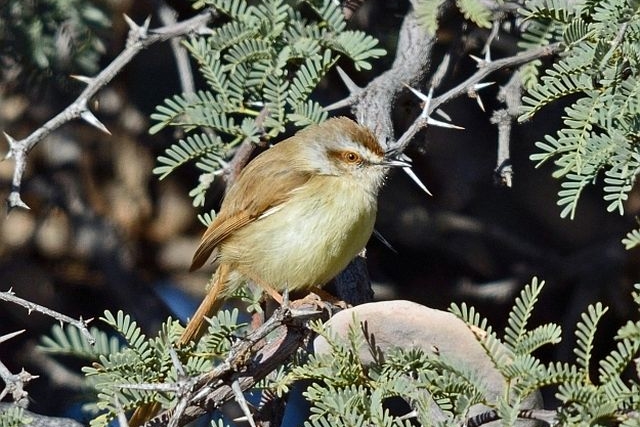 © BluTuna
© BluTuna
Non-breeding
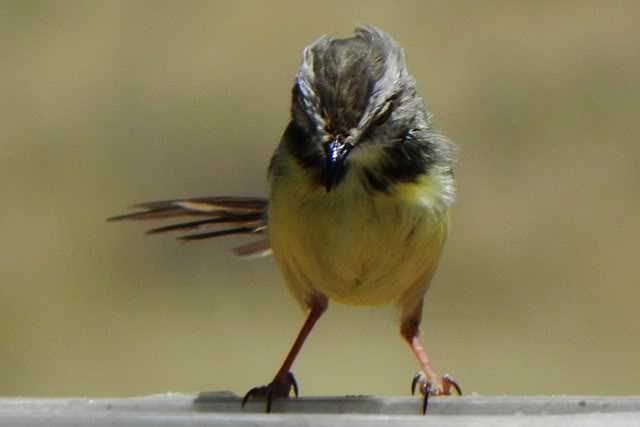 © Mel
© Mel
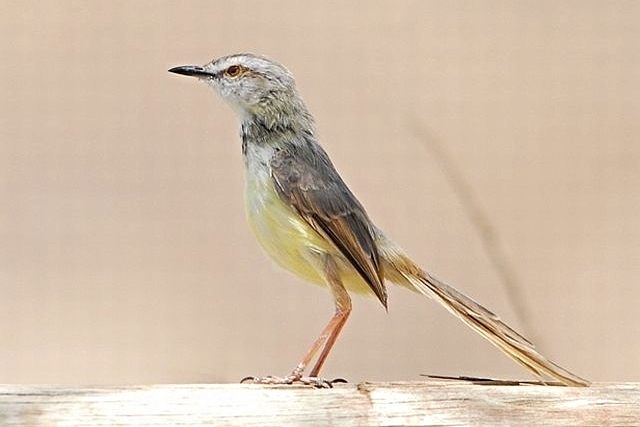 © Mel
© Mel
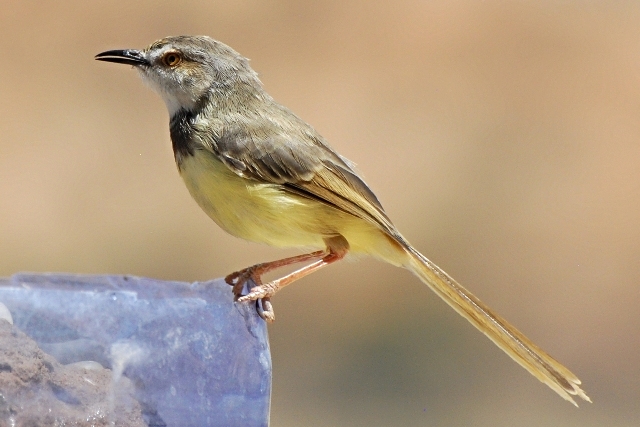 © Mel
© Mel
Kgalagadi Transfrontier Park
 © Mel
© Mel
Kgalagadi Transfrontier Park
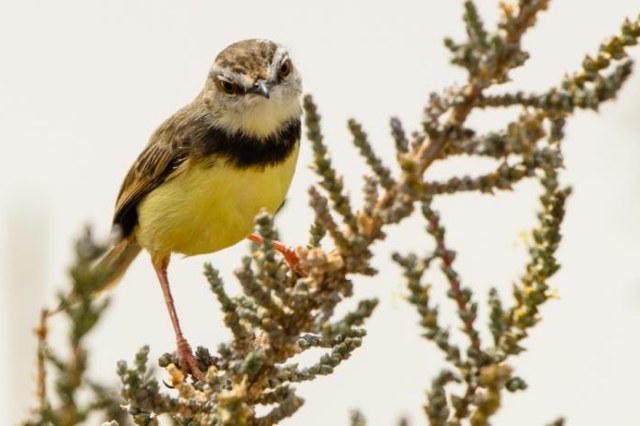 © Peter Connan
© Peter Connan
Kgalagadi Transfrontier Park, Upper Dune Road, Moravet Waterhole
Links:
http://sabap2.adu.org.za/docs/sabap1/685.pdf
http://sabap2.adu.org.za/species_info.p ... #menu_left

 © BluTuna
© BluTunaNon-breeding
 © Mel
© Mel © Mel
© Mel © Mel
© MelKgalagadi Transfrontier Park
 © Mel
© MelKgalagadi Transfrontier Park
 © Peter Connan
© Peter ConnanKgalagadi Transfrontier Park, Upper Dune Road, Moravet Waterhole
Links:
http://sabap2.adu.org.za/docs/sabap1/685.pdf
http://sabap2.adu.org.za/species_info.p ... #menu_left
Dewi
What is the good of having a nice house without a decent planet to put it on? (H D Thoreau)
What is the good of having a nice house without a decent planet to put it on? (H D Thoreau)
Karoo Prinia
686. Karoo Prinia (formerly known as Spotted Prinia) Prinia maculosa (Karoolangstertjie)
Order: Passeriformes. Family: Cisticolidae
Description
12-14 cm long with short rounded wings, a longish tail, strong legs and a short straight black bill. The head has a whitish supercilium and the upperparts are brown. The throat and lower face are whitish with dark streaking and the rest of the underparts are yellowish white or yellow with distinct black streaking. The long tail has a dark spot near the end and is typically cocked up at an angle. The feet and legs are pinkish-brown, and the eye is dark brown. Sexes alike.
Juveniles are more yellow below and less streaked.
Similar species: The Karoo Prinia could be confused with Drakensberg Prinia, but is less yellow below and more heavily streaked on the breast. May be distinguished from Namaqua Warbler by its buff-tipped (not plain) undertail and the more heavily streaked front. Namaqua Warbler is far less strongly marked below. It may be confused with the Black-chested Prinia in non-breeding plumage.
Distribution
Endemic to southern Africa, occurring from the extreme south of Namibia to the Northern, Western and Eastern Cape, extending into the Free State and Lesotho. The Karoo Prinia is particularly abundant in the western Cape Province and adjacent regions.
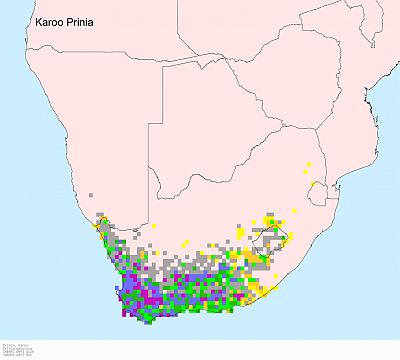
Habitat
It prefers shrubland such as fynbos, Karoo scrub and renosterveld but also occupying gardens, thickets of alien Acacia trees and strandveld.
Taxonomy
The former eastern subspecies P. m. hypoxantha is now usually considered to be a separate species, the Drakensberg Prinia, P. hypoxantha.
There are three subspecies: P. m. psammophila from extreme southern Namibia, western Northern Cape, and north-western Western Cape, is paler above than nominate; P. m. maculosa from Western Cape, Eastern cape and southern Northern Cape; P. m. exultans from Lesotho and adjacent parts of Eastern Cape and Free State, is more heavily streaked than nominate.
Diet
It eats a variety of small invertebrates, gleaning them from the leaves and stems of bushes.
Breeding
The nest is built by both sexes in about 4-14 days, consisting of an oval or pear shape with a side entrance, built of woven green grass which turns light brown over time. A thick lining of plant down or wool is added to it during incubation. It is typically conceals it in a tuft of spiny grass, sapling, shrub or bush, occasionally in a garden plant adjacent to a house; it may even place it in an old Yellow bishop or Southern red bishop nest. Egg-laying season is from July-January, peaking from August-November. The female lays 1-5 eggs, which are incubated solely by the female for approximately 11-17 days. The chicks are fed a variety of invertebrates by both parents, leaving the nest after about 10-14 days.
Call
Sharp chleet-chleet-chleet and loud, fast kli-kli-kli call; also other piping and chipping notes. Listen to Bird Call.
Status
Common endemic.
Order: Passeriformes. Family: Cisticolidae
Description
12-14 cm long with short rounded wings, a longish tail, strong legs and a short straight black bill. The head has a whitish supercilium and the upperparts are brown. The throat and lower face are whitish with dark streaking and the rest of the underparts are yellowish white or yellow with distinct black streaking. The long tail has a dark spot near the end and is typically cocked up at an angle. The feet and legs are pinkish-brown, and the eye is dark brown. Sexes alike.
Juveniles are more yellow below and less streaked.
Similar species: The Karoo Prinia could be confused with Drakensberg Prinia, but is less yellow below and more heavily streaked on the breast. May be distinguished from Namaqua Warbler by its buff-tipped (not plain) undertail and the more heavily streaked front. Namaqua Warbler is far less strongly marked below. It may be confused with the Black-chested Prinia in non-breeding plumage.
Distribution
Endemic to southern Africa, occurring from the extreme south of Namibia to the Northern, Western and Eastern Cape, extending into the Free State and Lesotho. The Karoo Prinia is particularly abundant in the western Cape Province and adjacent regions.

Habitat
It prefers shrubland such as fynbos, Karoo scrub and renosterveld but also occupying gardens, thickets of alien Acacia trees and strandveld.
Taxonomy
The former eastern subspecies P. m. hypoxantha is now usually considered to be a separate species, the Drakensberg Prinia, P. hypoxantha.
There are three subspecies: P. m. psammophila from extreme southern Namibia, western Northern Cape, and north-western Western Cape, is paler above than nominate; P. m. maculosa from Western Cape, Eastern cape and southern Northern Cape; P. m. exultans from Lesotho and adjacent parts of Eastern Cape and Free State, is more heavily streaked than nominate.
Diet
It eats a variety of small invertebrates, gleaning them from the leaves and stems of bushes.
Breeding
The nest is built by both sexes in about 4-14 days, consisting of an oval or pear shape with a side entrance, built of woven green grass which turns light brown over time. A thick lining of plant down or wool is added to it during incubation. It is typically conceals it in a tuft of spiny grass, sapling, shrub or bush, occasionally in a garden plant adjacent to a house; it may even place it in an old Yellow bishop or Southern red bishop nest. Egg-laying season is from July-January, peaking from August-November. The female lays 1-5 eggs, which are incubated solely by the female for approximately 11-17 days. The chicks are fed a variety of invertebrates by both parents, leaving the nest after about 10-14 days.
Call
Sharp chleet-chleet-chleet and loud, fast kli-kli-kli call; also other piping and chipping notes. Listen to Bird Call.
Status
Common endemic.
Dewi
What is the good of having a nice house without a decent planet to put it on? (H D Thoreau)
What is the good of having a nice house without a decent planet to put it on? (H D Thoreau)
Karoo Prinia Photos
686. Karoo Prinia Prinia maculosa
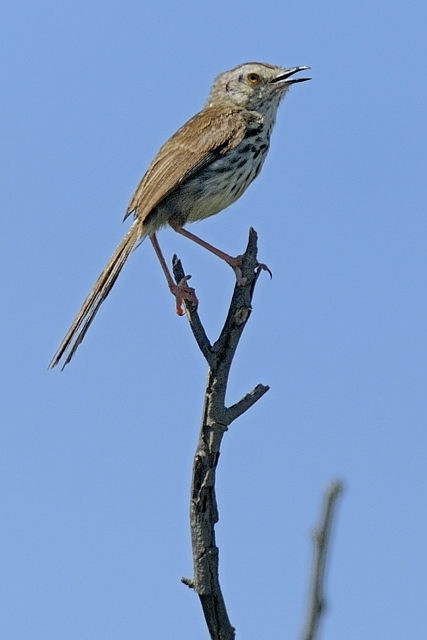 © Dewi
© Dewi
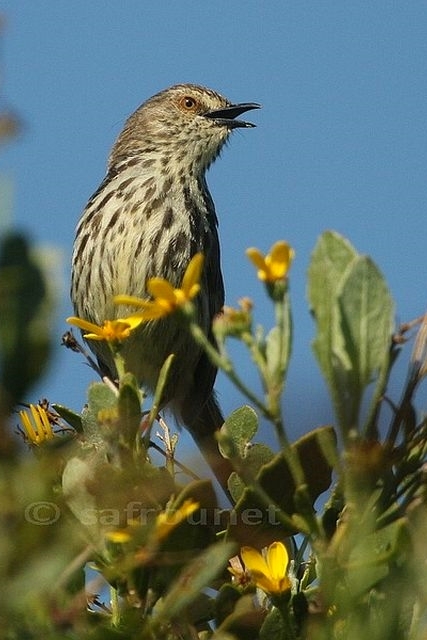 © nan
© nan
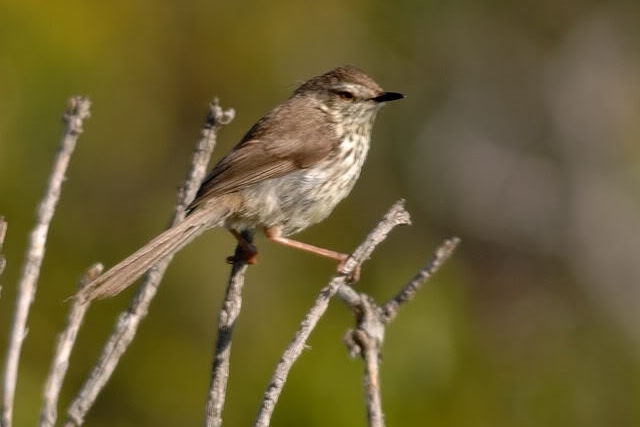 © Dewi
© Dewi
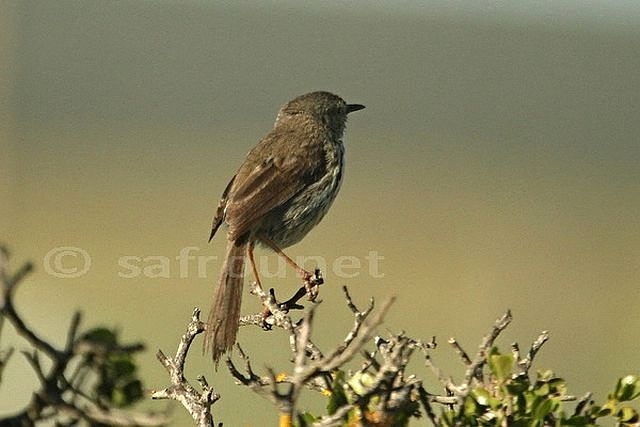 © nan
© nan
West Coast National Park
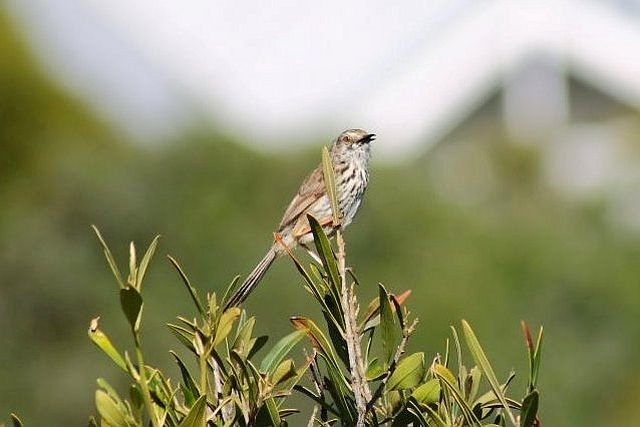 © Flutterby
© Flutterby
Camps Bay, Western Cape
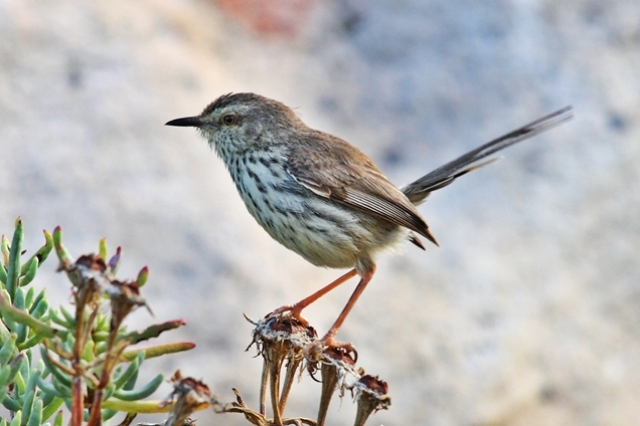 © Flutterby
© Flutterby
Kirstenbosch, Cape Town
Links:
Species text Sabap1
Sabap2
 © Dewi
© Dewi © nan
© nan © Dewi
© Dewi © nan
© nanWest Coast National Park
 © Flutterby
© FlutterbyCamps Bay, Western Cape
 © Flutterby
© FlutterbyKirstenbosch, Cape Town
Links:
Species text Sabap1
Sabap2
Dewi
What is the good of having a nice house without a decent planet to put it on? (H D Thoreau)
What is the good of having a nice house without a decent planet to put it on? (H D Thoreau)
- Lisbeth
- Site Admin
- Posts: 65876
- Joined: Sat May 19, 2012 12:31 pm
- Country: Switzerland
- Location: Lugano
- Contact:
Drakensberg Prinia
686.1 Drakensberg Prinia Prinia hypoxantha (Drakensberglangstertjie)
Order: Passeriformes. Family: Cisticolidae
Description
The Drakensberg Prinia is 12–14 cm long, with short rounded wings, a longish tail, strong legs and a short straight black bill. The head has a whitish eyebrow and the upperparts are otherwise brown. The throat and lower face are whitish with no streaking and the rest of the underparts are yellowish with dark streaking. The long tail has a dark spot near the end and is typically cocked up at an angle. The feet and legs are pinkish-brown, and the eye is pale.
The sexes are identical, but juveniles are paler below than the adults.
Similar species: The Drakensberg Prinia can only be confused with the closely related Karoo Prinia, but that species has less yellow underparts with heavier spotting. Although closely allied to the Karoo Prinia, the ranges of these two species are allopatric. The Drakensberg Prinia can be differentiated by the light streaking on its throat only and the yellow wash is brighter.
Distribution
Endemic to South Africa and Swaziland, occurring from the Eastern Cape, KwaZulu-Natal and Free State Province to Swaziland, Mpumalanga and Lesotho: Soutpansberg and escarpment of E South Africa and W Swaziland, S through midlands of KwaZulu-Natal to Eastern Cape (around East London).
Habitat
It generally prefers dense grass and shrubs at the bases of valleys, or along hillsides or watercourses, forest edge, wooded gullies and bracken-briar tangles, normally at higher elevation than Karoo Prinia.
Diet
It mainly eats insects, gleaning them from the leaves and stems of grass and shrubs. The Drakensberg Prinia forages for insects low down in the grass and bushes.
Breeding
Breeds in Oct–Feb, mainly Nov–Jan. Probably monogamous; solitary, territorial throughout year. Nest oval to pear-shaped, with a side-top entrance, built of woven green grass which dry to a pale brown colour. It is typically placed in a bush or dense weed, up to about a metre above ground. It lays 2-4 eggs, which in one observation where incubated for 14 days. The chicks are fed by both parents, leaving the nest after approximately 15 days.
Call
The calls of this species include a sharp chleet-chleet-chleet-chleet-chleet-chleet, and a fast buzzy tit-tit-tit-tit-tit.
Status
Common resident; endemic
Order: Passeriformes. Family: Cisticolidae
Description
The Drakensberg Prinia is 12–14 cm long, with short rounded wings, a longish tail, strong legs and a short straight black bill. The head has a whitish eyebrow and the upperparts are otherwise brown. The throat and lower face are whitish with no streaking and the rest of the underparts are yellowish with dark streaking. The long tail has a dark spot near the end and is typically cocked up at an angle. The feet and legs are pinkish-brown, and the eye is pale.
The sexes are identical, but juveniles are paler below than the adults.
Similar species: The Drakensberg Prinia can only be confused with the closely related Karoo Prinia, but that species has less yellow underparts with heavier spotting. Although closely allied to the Karoo Prinia, the ranges of these two species are allopatric. The Drakensberg Prinia can be differentiated by the light streaking on its throat only and the yellow wash is brighter.
Distribution
Endemic to South Africa and Swaziland, occurring from the Eastern Cape, KwaZulu-Natal and Free State Province to Swaziland, Mpumalanga and Lesotho: Soutpansberg and escarpment of E South Africa and W Swaziland, S through midlands of KwaZulu-Natal to Eastern Cape (around East London).
Habitat
It generally prefers dense grass and shrubs at the bases of valleys, or along hillsides or watercourses, forest edge, wooded gullies and bracken-briar tangles, normally at higher elevation than Karoo Prinia.
Diet
It mainly eats insects, gleaning them from the leaves and stems of grass and shrubs. The Drakensberg Prinia forages for insects low down in the grass and bushes.
Breeding
Breeds in Oct–Feb, mainly Nov–Jan. Probably monogamous; solitary, territorial throughout year. Nest oval to pear-shaped, with a side-top entrance, built of woven green grass which dry to a pale brown colour. It is typically placed in a bush or dense weed, up to about a metre above ground. It lays 2-4 eggs, which in one observation where incubated for 14 days. The chicks are fed by both parents, leaving the nest after approximately 15 days.
Call
The calls of this species include a sharp chleet-chleet-chleet-chleet-chleet-chleet, and a fast buzzy tit-tit-tit-tit-tit.
Status
Common resident; endemic
Last edited by Lisbeth on Fri May 02, 2014 1:02 pm, edited 1 time in total.
"Education is the most powerful weapon which you can use to change the world." Nelson Mandela
The desire for equality must never exceed the demands of knowledge
The desire for equality must never exceed the demands of knowledge
- Lisbeth
- Site Admin
- Posts: 65876
- Joined: Sat May 19, 2012 12:31 pm
- Country: Switzerland
- Location: Lugano
- Contact:
Drakensberg Prinia Photos
686.1 Drakensberg Prinia Prinia hypoxantha
 © Johan Drotsky
© Johan Drotsky
Links:
Species text Sabap1
Sabap2
NEWMAN'S VOELS VAN SA (8ste UIT)
 © Johan Drotsky
© Johan DrotskyLinks:
Species text Sabap1
Sabap2
NEWMAN'S VOELS VAN SA (8ste UIT)
"Education is the most powerful weapon which you can use to change the world." Nelson Mandela
The desire for equality must never exceed the demands of knowledge
The desire for equality must never exceed the demands of knowledge
-
Michele Nel
- Posts: 1994
- Joined: Mon Sep 10, 2012 10:19 am
- Country: South Africa
- Location: Cape Town
- Contact:
Bar-throated Apalis
645. Bar-throated Apalis Apalis thoracica (Bandkeelkleinjantjie)
Order: Passeriformes. Family: Cisticolidae
Description
The Bar-throated Apalis is one of the long-tailed warblers and is 11-13 cm in length. The plumage varies depending on the subspecies: the upperparts can be grey or green while the underparts are white or pale yellow. All forms have a narrow black band across the breast, white outer tail-feathers and a pale eye. The black bill is fairly long and slender and is slightly curved.
Females are similar to males but have a narrower breastband.
Juveniles have buffer underparts and may have an incomplete breastband.
Distribution
It is widespread in the southeastern quadrant of Africa, occurring from s. Kenya to southern Africa. Here it is common across much of Zimbabwe, central Mozambique, south-eastern Botswana and South Africa.
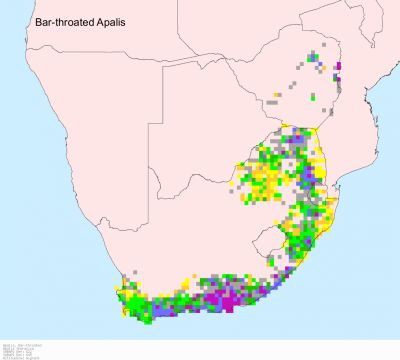
Habitat
It prefers evergreen forest, valley bushveld, woodland along drainage lines in the Karoo and scrub around sand dunes. It is occasionally found in grassland and alien tree stands and plantations.
Diet
It mainly eats invertebrates gleaned from leaves and twigs, supplemented with fruit.
Breeding
The nest is an oval ball with a side entrance, built of fine grass, moss, lichens and rootlets, secured with spider web. It is typically placed in the foliage of shrub, sapling or creeper, often 1-3 m above ground. Egg-laying season is mainly from August-March, peaking from November-December. It lays 2-4 bluish white eggs with reddish-brown spots, which are incubated by both sexes for about 14-18 days. The young are fed by both parents, leaving the nest after about 13-18 days, after which they are still dependent on their parents for food for some time.
Parasitised by Red-chested Cuckoo and Klaas's Cuckoo.
Call
Its call is a sharp, rapid, often repeated pillip-pillip-pillip. Pairs sing a duetting song with the female's call being higher-pitched than that of the male. Listen to Bird Call.
Status
Common resident.
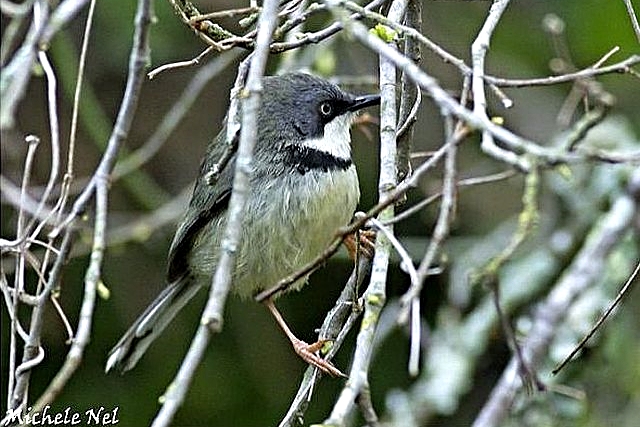
Order: Passeriformes. Family: Cisticolidae
Description
The Bar-throated Apalis is one of the long-tailed warblers and is 11-13 cm in length. The plumage varies depending on the subspecies: the upperparts can be grey or green while the underparts are white or pale yellow. All forms have a narrow black band across the breast, white outer tail-feathers and a pale eye. The black bill is fairly long and slender and is slightly curved.
Females are similar to males but have a narrower breastband.
Juveniles have buffer underparts and may have an incomplete breastband.
Distribution
It is widespread in the southeastern quadrant of Africa, occurring from s. Kenya to southern Africa. Here it is common across much of Zimbabwe, central Mozambique, south-eastern Botswana and South Africa.

Habitat
It prefers evergreen forest, valley bushveld, woodland along drainage lines in the Karoo and scrub around sand dunes. It is occasionally found in grassland and alien tree stands and plantations.
Diet
It mainly eats invertebrates gleaned from leaves and twigs, supplemented with fruit.
Breeding
The nest is an oval ball with a side entrance, built of fine grass, moss, lichens and rootlets, secured with spider web. It is typically placed in the foliage of shrub, sapling or creeper, often 1-3 m above ground. Egg-laying season is mainly from August-March, peaking from November-December. It lays 2-4 bluish white eggs with reddish-brown spots, which are incubated by both sexes for about 14-18 days. The young are fed by both parents, leaving the nest after about 13-18 days, after which they are still dependent on their parents for food for some time.
Parasitised by Red-chested Cuckoo and Klaas's Cuckoo.
Call
Its call is a sharp, rapid, often repeated pillip-pillip-pillip. Pairs sing a duetting song with the female's call being higher-pitched than that of the male. Listen to Bird Call.
Status
Common resident.

-
Michele Nel
- Posts: 1994
- Joined: Mon Sep 10, 2012 10:19 am
- Country: South Africa
- Location: Cape Town
- Contact:
Bar-throated Apalis Photos
645. Bar-throated Apalis Apalis thoracica (Bandkeelkleinjantjie)
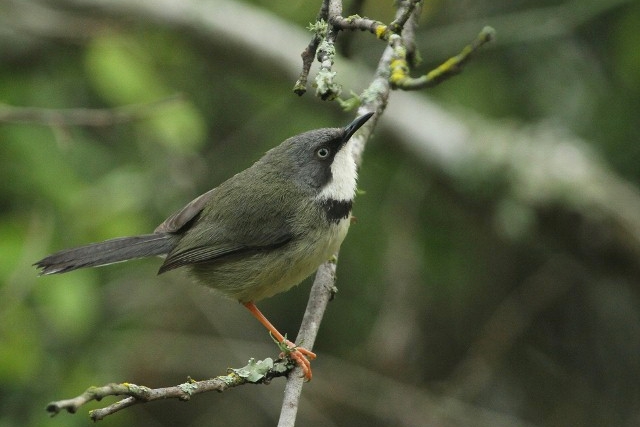 © nan
© nan
Addo Elephant National Park
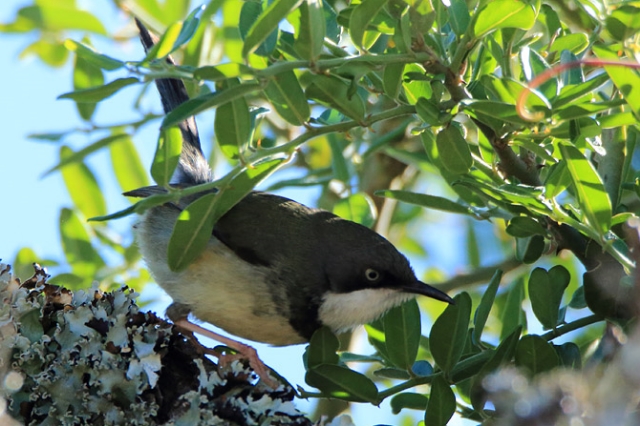 © PJL
© PJL
Addo Elephant National Park
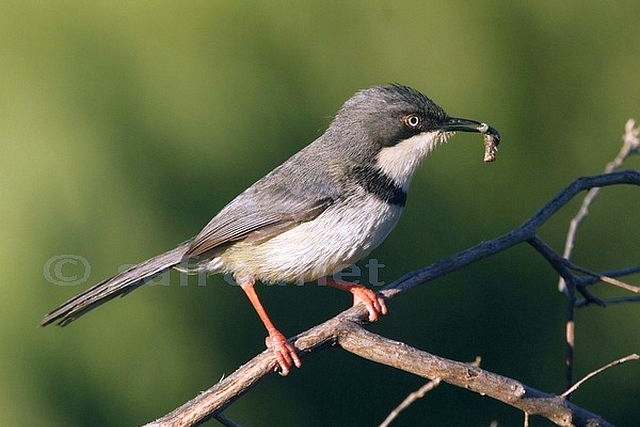 © nan
© nan
Western Cape
Links:
Species text Sabap1
Sabap2
Biodiversity Explorer
Wikipedia: http://en.wikipedia.org/wiki/Bar-throated_Apalis
 © nan
© nanAddo Elephant National Park
 © PJL
© PJLAddo Elephant National Park
 © nan
© nanWestern Cape
Links:
Species text Sabap1
Sabap2
Biodiversity Explorer
Wikipedia: http://en.wikipedia.org/wiki/Bar-throated_Apalis


